Shared Facilities
Atomic Force Microscope
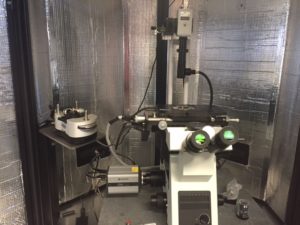 We recently acquired a scanning probe facility through an NSF Major Research Instrumentation (MRI) grant. This instrumentation request includes an atomic force microscope (Asylum MFP-3D) coupled to an optical microscope (Olympus) for simultaneous imaging and physical properties measurements at the nanoscale for a wide range of advanced materials in renewable energy and life sciences. The unique feature of the proposed SPM facility is its ability to measure electrical and mechanical properties of materials in direct registry with topography at nanoscale resolution under their designed operating conditions (e.g illumination of photovoltaics and hydrated conditions for biological). The measurement of interfacial physical properties at small length scales is essential to the development of the next generation of materials for renewable energy and life sciences. Specific advanced capabilities beyond standard SPM modes (contact, tapping, phase) include:
We recently acquired a scanning probe facility through an NSF Major Research Instrumentation (MRI) grant. This instrumentation request includes an atomic force microscope (Asylum MFP-3D) coupled to an optical microscope (Olympus) for simultaneous imaging and physical properties measurements at the nanoscale for a wide range of advanced materials in renewable energy and life sciences. The unique feature of the proposed SPM facility is its ability to measure electrical and mechanical properties of materials in direct registry with topography at nanoscale resolution under their designed operating conditions (e.g illumination of photovoltaics and hydrated conditions for biological). The measurement of interfacial physical properties at small length scales is essential to the development of the next generation of materials for renewable energy and life sciences. Specific advanced capabilities beyond standard SPM modes (contact, tapping, phase) include:
- Optical Microscopy: The AFM head is integrated with an inverted optical microscope, facilitating the quick identification of the specific region of interest and enables optical stimulation to obtain properties such as a photoconductivity or fluorescence in registry with topology.
- Electro/Mechanical Measurements: The instrument enable spatially resolved measurements of critical material properties such as conductivity, piezoelectricity, Kelvin Probe, modulus, and viscoelasticity.
- Environmental Control: Sample may be evaluated under controlled conditions: temperature (-35-300 °C), humidity, fluid cells, and illumination intensity/wavelength.
- For additional information about training/sample analysis please contact Mark or Colin directly. We gratefully acknowledge the National Science Foundation and Colorado School of Mines for funding this facility through award #CBET-1532179.
TGA / DSC
 We have two tools to analyze the thermal stability of various materials. First is a the Q50 thermogravimetric analyzer (TGA) from TAInstruments. This compact, general purpose TGA offers integral mass flowcontrol, gas switching capability, superb software, and ease-of-use. The Q50 can operate up to 1000 ºC with heating rates ranging from 0.1 to 100°C/min.
We have two tools to analyze the thermal stability of various materials. First is a the Q50 thermogravimetric analyzer (TGA) from TAInstruments. This compact, general purpose TGA offers integral mass flowcontrol, gas switching capability, superb software, and ease-of-use. The Q50 can operate up to 1000 ºC with heating rates ranging from 0.1 to 100°C/min.
In addition we have a Perkin Elmer differential scanning calorimeter (DSC7). The DSC is is used to accurately measure melting points , glass transitions, and heats of fusion. Typical temperature range is from 10 to 400 ºC. The temperature scale is calibrated using a two-point calibration, measuring the onset temperatures of indium and zinc standards. The enthalpy scale is calibrated using the observed delta-H from an accurately known amount of indium.
, glass transitions, and heats of fusion. Typical temperature range is from 10 to 400 ºC. The temperature scale is calibrated using a two-point calibration, measuring the onset temperatures of indium and zinc standards. The enthalpy scale is calibrated using the observed delta-H from an accurately known amount of indium.
Rheometer
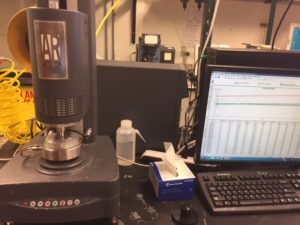 CIEMACS maintains an ARES-2 rheometer for viscoelastic property measurement. The ARES-G2 is the most advanced rotational rheometer for research and material development. It remains the only commercially available rheometer with a dedicated actuator for deformation control, Torque Rebalance Transducer (TRT), and Force Rebalance Transducer (FRT) for independent shear stress and normal stress measurements. It is recognized by the rheological community as the industry standard to which all other rheometer measurements are compared for accuracy.
CIEMACS maintains an ARES-2 rheometer for viscoelastic property measurement. The ARES-G2 is the most advanced rotational rheometer for research and material development. It remains the only commercially available rheometer with a dedicated actuator for deformation control, Torque Rebalance Transducer (TRT), and Force Rebalance Transducer (FRT) for independent shear stress and normal stress measurements. It is recognized by the rheological community as the industry standard to which all other rheometer measurements are compared for accuracy.
X-Ray Fluorescence
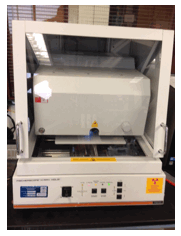 The Fisherscope X-Ray Fluorescence (XRF) tool is useful for quantifying the thickness and composition of micron thick films such as copper indium gallium diselendide CIGS) photovoltaic absorbers and Pd based dense metal alloy membranes. The usage of this XRF tool requires the users to wear a dosemeter that will monitor X-ray exposure.
The Fisherscope X-Ray Fluorescence (XRF) tool is useful for quantifying the thickness and composition of micron thick films such as copper indium gallium diselendide CIGS) photovoltaic absorbers and Pd based dense metal alloy membranes. The usage of this XRF tool requires the users to wear a dosemeter that will monitor X-ray exposure.
FTIR
 The Nexus FTIR spectrometer is configured for conventional transmission analysis form 400 – 4000 cm-1, with a liquid nitrogen cooled MCT detector available for enhanced sensitivity at low wavenumbers.
The Nexus FTIR spectrometer is configured for conventional transmission analysis form 400 – 4000 cm-1, with a liquid nitrogen cooled MCT detector available for enhanced sensitivity at low wavenumbers.
ZetaPALS
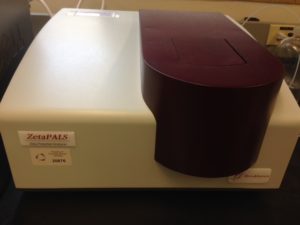 ZetaPALS employs light scattering to probe the state of colloidal suspensions. The first principle application of this tool is to determine the zeta potential, which is a measure of the amount of surface charge on a particle. Second, light scattering is used to determine the particle size distribution of colloids or nanoparticles in solution.
ZetaPALS employs light scattering to probe the state of colloidal suspensions. The first principle application of this tool is to determine the zeta potential, which is a measure of the amount of surface charge on a particle. Second, light scattering is used to determine the particle size distribution of colloids or nanoparticles in solution.
Variable Angle Spectroscopic Ellipsometer
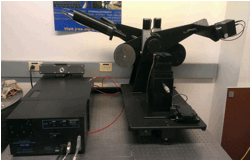 This is the J.A. Woollam variable angle spectroscopic ellipsometer (VASE) that is used for characterizing the thickness and optical properties of thin films. The instrument collects psi-delta information over a wavelength range of 250-1300 nm at the full range of incident angles (0 – 90). Woollam software applies standard models (Cauchy, Tauc-Lorenz, etc.) to extract wavelength-dependent values of refractive index, absorption coefficient, etc.
This is the J.A. Woollam variable angle spectroscopic ellipsometer (VASE) that is used for characterizing the thickness and optical properties of thin films. The instrument collects psi-delta information over a wavelength range of 250-1300 nm at the full range of incident angles (0 – 90). Woollam software applies standard models (Cauchy, Tauc-Lorenz, etc.) to extract wavelength-dependent values of refractive index, absorption coefficient, etc.